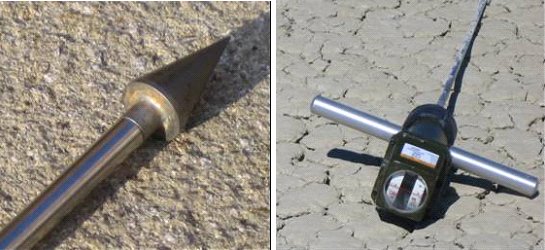by Andy Green
The surface of a dry salt lake such as Bonneville is very hard, almost like concrete – putting in a tent peg to support a sunshade generally requires a drill or a large hammer, for instance. However, the surface of an alkali playa like the black Rock Desert is much softer. In selecting an alkali surface, or surfaces, for BLOODHOUND we need to be able to measure the hardness (or softness) of the different deserts.
There are various methods for measuring the strength of a natural surface, mostly used by civil engineers to give an idea of how much strengthening the foundations of a building or road will require. A common measure of hardness is the California Bearing Ratio (CBR) which was developed, as you might guess, by the California State Highways Department. Put simply, it tries to answer the question ‘How strong is the ground upon which we are going to build a road?'. It is in essence a simple penetration test developed to evaluate the strength of road subgrades, and involves pushing a plunger of standard area into the surface of a soil sample. The test can be done in the laboratory under precisely controlled conditions, or on site using a vehicle-mounted hydraulic rig. However, we need a very simple way to test desert surface hardness without having to use vehicles and laboratories – and the Cone Penetrometer is our answer.
 The Cone Penetrometer is a hand held probe, designed by the military for simple and rapid measurement of surface hardness. The penetrometer is still used by the military today in a variety of ways. For instance, in my previous job running the airfield at RAF Wittering, we had a grass strip which the Harriers can use (indeed they are the only fast jets in the world that can!). The hardness of the surface was checked before use with a Cone Penetrometer.
The Cone Penetrometer is a hand held probe, designed by the military for simple and rapid measurement of surface hardness. The penetrometer is still used by the military today in a variety of ways. For instance, in my previous job running the airfield at RAF Wittering, we had a grass strip which the Harriers can use (indeed they are the only fast jets in the world that can!). The hardness of the surface was checked before use with a Cone Penetrometer.
Picture right: Harrier operations from grass.
 The penetrometer has a simple cone which is pushed into the surface on the end of a metal rod, and a spring balance that reads off the amount of force required. The penetrometer can give an indication of CBR using a small (12.5mm diameter) cone. We chose to use the larger (20 mm diameter) cone more suited to the deserts that we are interested in. With this larger cone fitted, the penetrometer gives a direct reading (in pounds per square inch, as the Americans devised the scale) of the pressure that the surface can support as the cone is pushed into the surface. This reading, known as the Cone Index, is our measure of hardness for potential BLOODHOUND running sites. While there is no exact limit for minimum hardness, we are looking for a Cone Index of over 150, and preferably over 200, to run the car.
The penetrometer has a simple cone which is pushed into the surface on the end of a metal rod, and a spring balance that reads off the amount of force required. The penetrometer can give an indication of CBR using a small (12.5mm diameter) cone. We chose to use the larger (20 mm diameter) cone more suited to the deserts that we are interested in. With this larger cone fitted, the penetrometer gives a direct reading (in pounds per square inch, as the Americans devised the scale) of the pressure that the surface can support as the cone is pushed into the surface. This reading, known as the Cone Index, is our measure of hardness for potential BLOODHOUND running sites. While there is no exact limit for minimum hardness, we are looking for a Cone Index of over 150, and preferably over 200, to run the car.
Left: Using the Cone Penetrometer at Diamond Valley, Nevada.
Below: Cone Penetrometer and the 20mm cone


